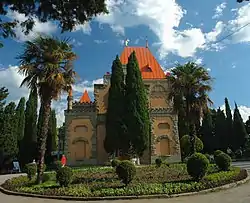Sanatorium (resort)
In Soviet Union and post-Soviet countries, the term sanatorium[lower-alpha 1] is generally used for a combination resort/recreational facility and a medical facility to provide short-term complex rest and medical services. It is similar to spa resorts but with medical services.
On the other hand, for most residents of the Warsaw Pact countries, sanatorium mostly means a kind of hotel with health resort facilities and various available services (such as massage, pools, saunas, aromatherapy, oxygen therapy, etc.) not covered by medical insurance. It is mostly, without any double connotation, a spa resort where relatively healthy people can rest and recuperate during a regular job vacation. For example, Sanatorium Astória[1] and others located in Karlovy Vary, Czech Republic, or Geneva Sanatorium Hotel in Ukraine, serve this purpose.[2] Usually in this case a doctor's prescription is not required. However, a general practitioner is available and it is recommended guests check their health status at the beginning and end of their stay.
Sanatoriums first began to achieve prominence in the Soviet Union in the early 1920s, with the introduction of the Labour Code of the Russian Soviet Federative Socialist Republic, which established basic recommendations and standards for workers in Russia (distinct labour codes of the Soviet republics would later be standardized in 1970).[3][4] This Labour Code guaranteed at least two weeks of annual leave for all workers,[5] recommending that it be spent at a sanatorium for health reasons. A medical professional would recommend a place and duration of stay (ranging from 24 days to 10 months), and the worker would file a form ("putyevka") for the recommended stay. The cost was partly or completely covered by unions or health insurance. By 1990, sanatoriums in the USSR could hold up to 50,000 guests at once.[4] After the dissolution of the Soviet Union, many sanatoriums fell into disrepair, some becoming refugee camps, but a number of sanatoriums across the former republics still operate.[4] Lake Issyk-Kul in Kyrgyzstan was known for its santoria, some of which have been refurbished.[6][7]
Notes
-
- Armenian: Առողջարան, romanized: Arroghjaran
- Azerbaijani: Sanatoriya
- Belarusian: Санаторый, romanized: Sanatory or здраўніца (zdraunitsa)
- Kazakh: Шипажай, romanized: Şipajai
- Kyrgyz: Санаторий, romanized: Sanatoriy
- Lithuanian: Sanatorija
- Turkmen: Sanatoriýalar
- Russian: Санаторий, romanized: Sanatory
- Ukrainian: Санаторій, romanized: Sanatorii, also лічниця (lichnytsia) or оздоровниця (ozdorovnytsia)
- Uzbek: Sanatoriy
References
- Sanatorium Astória
- Geneva Sanatorium Hotel, Truskavets, Ukraine
- Clark Brown, Emily (January 1973). "Fundamental Soviet Labor Legislation". ILR Review. 26 (2): 778–792. doi:10.1177/001979397302600203. JSTOR 2521681. S2CID 154969998.
- "These Soviet-Era Spas Are Still Accepting Guests". Wired. ISSN 1059-1028. Retrieved 2020-05-20.
- Principal current Soviet labor legislation: a compilation of documents. United States Bureau of Labor Statistics, United States Department of Labor. 1962. p. 20.
- International Business Publications, Usa (2009). Kyrgyzstan country : strategic information and. [Place of publication not identified]: Intl Business Pubns Usa. ISBN 978-1-4387-2792-9. OCLC 946224015.
{{cite book}}:|last=has generic name (help) - Environmental change and human security : recognizing and acting on hazard impacts. P. H. Liotta. Dordrecht: Springer. 2008. ISBN 978-1-4020-8551-2. OCLC 288469352.
{{cite book}}: CS1 maint: others (link)
